UNIT 3
METHODS OF TEACHING-LEARNING ENGLISH AS A SECOND LANGUAGE
Method may be defined as: "The process of planning, selection and grading language materials and items, techniques of teaching", etc.
The history of language teaching presents a fascinating variety of methods. But, there is no single method that is to be considered effective and accepted by all. Different methods may be appropriate to different contexts. The following are some of the important methods to teach English as a second language:

1. The Direct Method: this approach was developed initially as reaction to the grammar-translation method in an attempt to integrate more use of the target language in instruction.
Lessons begin with a dialogue using a modern conversational style in the target language. Material is first presented orally with actions or pictures. The mother tongue is never used. There is no translation. Grammar is taught inductively-rules are generalized from the practice and experience with the target language. Verbs are used first and systematically conjugated only much later after some oral mastery of the target language. The culture associated with the target language is also taught inductively. In this method the teaching is done entirely in the target language. The learner is not allowed to use his or her mother tongue.
The direct method enjoyed great popularity at the end of 19th century and the beginning of the 20th century but it was difficult to use, mainly because of the constraints of budget, time, audio visual aids, and classroom size. Yet, after a period of decline, this method has been revived, leading to the emergence of the audio-lingual method.
2. The Grammar Translation Method: this method instructs students to grammar, and provides vocabulary with direct translations to memorize. It was the predominant method in Europe in the 19th century.
2. The Grammar Translation Method: this method instructs students to grammar, and provides vocabulary with direct translations to memorize. It was the predominant method in Europe in the 19th century.
"This method emphasizes reading, writing, translation and conscious learning of grammatical rules. Its primary goal is to develop literary mastery of the second language. Memorization is the main learning instead of talking in the language. The curriculum requires the memorization of paradigms, patterns, and vocabulary, with translation being used to test the acquired knowledge. Consequently, the role of L1 (i.e. mother tongue or native language) is quite prominent" (O Grady, et al.1993).
This method favours to teach English by rules not by use. Language learning means speaking and reading but translation in mother tongue prevents students to read and speak in English. Students get no opportunities to participate in the discussions of the unit. Translations into mother tongue affect the originality of the words. It prevents students to think directly in English. Thus, it prevents establishing of direct bond between thought and expression.
Most of the instructors acknowledge that this method is ineffective by itself. This method does not enhance the students' communicative ability in the foreign language.

3. The Audio-Lingual Method (ALM): during First World War, the American army began intensive oral/aural courses known as the 'Army specialized Training Programme' (ASTP) and were later adopted by educational institutions as the audio lingual method (Brown, 2000.74).

This method is based on the principle that language learning is habit formation; the method fosters dependence on mimicry, memorization of set phrases and over-learning. Structures are sequenced and taught once at a time. Structural patterns are taught using repetitive drills. Little or no grammatical explanations are provided, grammar is taught inductively. Vocabulary is strictly limited and learned in context. Teaching points are determined by contrastive analysis between L1 and L2. Great importance is given to precise native-like pronunciation. Use of mother tongue by the teacher is permitted, but discouraged by the learners. There is a tendency to focus on manipulation of the target language and to disregard content and meaning.
The audio-lingual method began to decline as students failed to achieve long-term communicative capability. It was realized that habit formation, over learning and avoidance of errors was not the best way to learn a second language (Brown, 2000.75). Although, this method provided potentially good tools for SLA, its lack of concentration on meaning and fluency detracted from its success.
The structural approach sees language as a complex of grammatical rules which are to be learned one at a time in a set order. So for example the verb "to be" is introduced and practised before the present continuous tense which uses "to be" as an auxiliary.
 5. Suggestopedia: the theory underlying this method is that a language can be acquired only when the learner is receptive and has no mental blocks. By various methods it is suggested to the student that the language is easy - and in this way the mental blocks to learning are removed.
5. Suggestopedia: the theory underlying this method is that a language can be acquired only when the learner is receptive and has no mental blocks. By various methods it is suggested to the student that the language is easy - and in this way the mental blocks to learning are removed.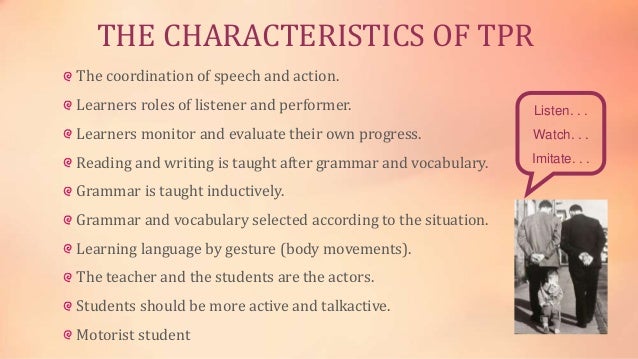 6. Total Physical Response (TPR): the method is an example of the comprehension approach to language teaching. The listening and responding (with actions) serves two purposes: It is a means of quickly recognizing meaning in the language being learned, and a means of passively learning the structure of the language itself. Grammar is not taught explicitly, but can be learned from the language input. TPR is a valuable way to learn vocabulary, especially idiomatic terms, e.g., phrasal verbs.
6. Total Physical Response (TPR): the method is an example of the comprehension approach to language teaching. The listening and responding (with actions) serves two purposes: It is a means of quickly recognizing meaning in the language being learned, and a means of passively learning the structure of the language itself. Grammar is not taught explicitly, but can be learned from the language input. TPR is a valuable way to learn vocabulary, especially idiomatic terms, e.g., phrasal verbs.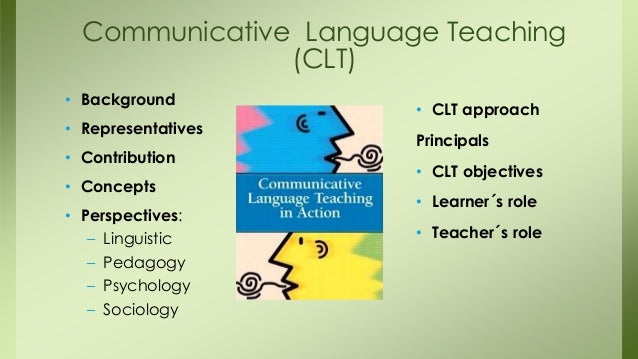 7. Communicative Language Teaching (CLT): this method makes use of real life situations that students are likely to encounter in real life. The real life simulations change from day to day students' motivation to learn comes from their desire to communicate in meaningful ways about meaningful topics.
7. Communicative Language Teaching (CLT): this method makes use of real life situations that students are likely to encounter in real life. The real life simulations change from day to day students' motivation to learn comes from their desire to communicate in meaningful ways about meaningful topics.
In CLT communication means using language to make request, give advice, agree and disagree, complain, praise, to try to persuade people to do things and so on. The focus should be on meaning not on form.
Communication goals can be specified. One can accurately describe what learners should have learned and be able to do with language at the end of the lesson. E.g. Students will be able to;
- Talk about their jobs, and ask classmates about theirs.
- Use the present simple accurately and fluently in this context.
- Good communicative teaching is learner centered, not teacher centered.
- The classroom and the behaviour of teachers and learners in the classroom should be as similar as possible to the behaviour of people in the real-world outside the classroom.
8. The Silent Way: this is so called because the aim of the teacher is to say as little as possible in order that the learner can be in control of what he wants to say. No use is made of the mother tongue.
8. The Silent Way: this is so called because the aim of the teacher is to say as little as possible in order that the learner can be in control of what he wants to say. No use is made of the mother tongue.
The method emphasizes learner autonomy and active student participation. Silence is used as a tool to achieve this goal; the teacher uses a mixture of silence and gestures to focus students' attention, to elicit responses from them, and to encourage them to correct their own errors. Pronunciation is seen as fundamental to the method, with a great deal of time spent on it each lesson. The Silent Way uses a structural syllabus and concentrates on teaching a small number of functional and versatile words. Translation and rote repetition are avoided, and the language is usually practiced in meaningful contexts. Evaluation is carried out by observation, and the teacher may never set a formal test.
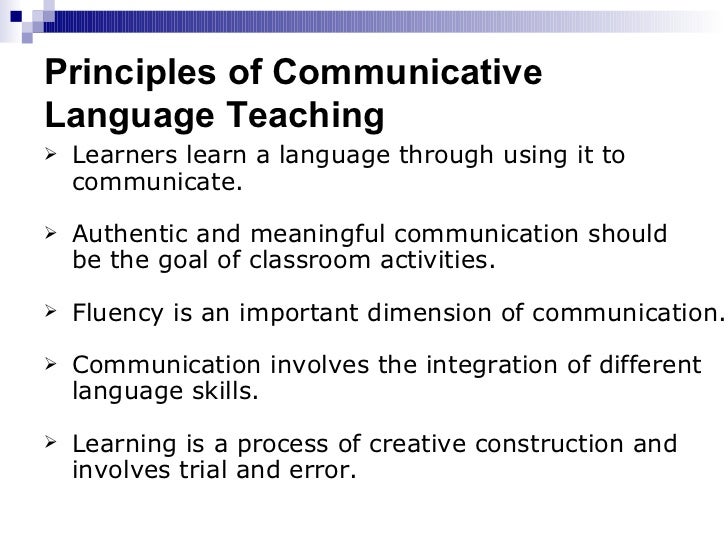 9. Communicative Language Learning: In this method attempts are made to build strong personal links between the teacher and student so that there are no blocks to learning. There is much talk in the mother tongue which is translated by the teacher for repetition by the student.
9. Communicative Language Learning: In this method attempts are made to build strong personal links between the teacher and student so that there are no blocks to learning. There is much talk in the mother tongue which is translated by the teacher for repetition by the student.
Community language learning (CLL) is language-teaching method in which students work together to develop what aspects of a language they would like to learn. It is based on the Counseling-approach in which the teacher acts as a counsellor and a paraphraser, while the learner is seen as a client and collaborator.
The CLL emphasizes the sense of community in the learning group, it encourages interaction as a vehicle of learning, and it considers as a priority the students' feelings and the recognition of struggles in language acquisition. There is no syllabus or textbook to follow and it is the students themselves who determine the content of the lesson by means of meaningful conversations in which they discuss real messages. Notably, it incorporates translation, transcription, and recording techniques.
10. Immersion: this corresponds to a great extent to the situation we have at our school. ESL students are immersed in the English language for the whole of the school day and expected to learn math, science, humanities etc. through the medium of the target language, English.
Immigrant students who attend local schools find themselves in an immersion situation; for example refugee children from Bosnia attending German schools, or Puerto Ricans in American schools.
Task-based language teaching proposes the notions of 'task' as a central unit of planning and teaching.
In recent years, vocabulary has been considered to play a more central role in second language learning than was traditionally assumed. Vocabulary is here used to include the consideration of lexical phrases, sentence stems, prefabricated routines and collocations and not only words as significant units of linguistic lexical analysis and language pedagogy.
Later, a set of role-play activities was then developed focusing on situations students would encounter in the community and transactions they would have to carry out in English.
Task-based language teaching provides more effective basis for teaching than other language teaching approaches.
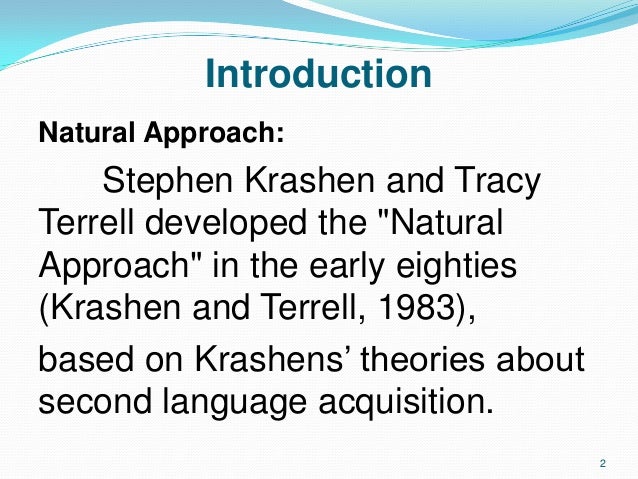 12. The Natural Approach: this approach, propounded by Professor S. Krashen, stresses the similarities between learning the first and second languages. There is no correction of mistakes. Learning takes place by the students being exposed to language that is comprehensible or made comprehensible to them.
12. The Natural Approach: this approach, propounded by Professor S. Krashen, stresses the similarities between learning the first and second languages. There is no correction of mistakes. Learning takes place by the students being exposed to language that is comprehensible or made comprehensible to them.13. The Lexical Syllabus: this approach is based on a computer analysis of language which identifies the most common (and hence most useful) words in the language and their various uses. The syllabus teaches these words in broadly the order of their frequency, and great emphasis is placed on the use of authentic materials.
 A lexical approach in language teaching refers to one derived from the belief that the building blocks of language learning and communication are not grammar, functions, notions or some other unit of planning and teaching but lexis, i.e. words and word combinations. Lexical approach in language teaching reflects a belief in the centrality of the lexicon to language structure, second language learning and language use, and in particular to multiword lexical units or "Chunks" that are learned and used as single items. Linguistic theory has also recognized a more central role for vocabulary in linguistic description. Linguistic theory has also recognized more central role for vocabulary in linguistic description.
A lexical approach in language teaching refers to one derived from the belief that the building blocks of language learning and communication are not grammar, functions, notions or some other unit of planning and teaching but lexis, i.e. words and word combinations. Lexical approach in language teaching reflects a belief in the centrality of the lexicon to language structure, second language learning and language use, and in particular to multiword lexical units or "Chunks" that are learned and used as single items. Linguistic theory has also recognized a more central role for vocabulary in linguistic description. Linguistic theory has also recognized more central role for vocabulary in linguistic description.
Lexical approach in language teaching seeks to develop proposals for syllabus design and language teaching founded on a view of language in which lexis plays a central role.
METHOD/APPROACH
|
LANGUAGE/CULTURE
|
LANGUAGE LEARNING
|
LANGUAGE TEACHING
|
Grammar Translation
|
Literary Language.
Culture: Literature and the fine arts.
|
Exercise Mental muscle
|
Have students translate from target language (TL) texts to native language.
|
Direct Method
|
Every Spoken Language.
Culture: history, geography, everyday life of TL, speakers.
|
Associate meaning with the TL directly
|
Use spoken language in situations with no native-language translation
|
Audio-Lingual Method
|
Sentence and sound pattern
|
Dialog.
Overcome native language habits; from new TL habits.
|
Conduct oral/ aural drill and pattern practice.
|
Cognitive Code Approach
|
Grammar rules
|
Form and test hypotheses to discover and acquire TL rules
|
Do inductive, deductive grammar exercises
|
Silent way
|
Unique spirit/melody
|
Develop inner criteria for correctness by becoming aware of how the TL works
|
Remain silent in order to
|
Desuggestopedia
|
Whole, meaningful, texts; vocabulary emphasized
|
Overcome
Psychological
Barriers to learning
|
Desuggest
Limitations:
Teach lengthy
dialogs through
musical accompaniment, playful practice, and the arts
|
Community Language Learning
|
Student generated
|
Learn condefensively as whole persons, following developmental stages
|
Include the elements of security, attention, aggression, reflection, retention, discrimination
|
Comprehension Approach:
Natural Approach, the learnables, and total Physical Response
|
Vehicle for communicating meaning; vocabulary emphasized
|
Listen; associate meaning with TL directly
|
Delay speaking until students are ready; make meaning clear through actions and visuals
|
Communicative Language Teaching
|
Communicative competence
Notions/functions
Authentic discourse
|
Interact with others in the TL; negotiate meaning
|
Use information gaps, role plays, games.
|
Conten-based, Task-based. And Participatory Approaches
|
Medium for doing/learning
|
Attend to what is being communicated, not the language itself, except when form-focused
Learn how to learn
|
Engege students in learning other subject matter, tasks, or in problem-solving around issues in their lives.
|
Learning Strategy Training, Cooperative Learning, and Multiple Intelligences
|
Learn how to learn
|
Teach learning strategies, cooperation; use a variety of activities that appeal intelligences
|
BIBLIOGRAPHIC REFERENCES
http://www.ukessays.com/essays/english-language/history-of-the-naturalistic-theory-english-language-essay.php
• http://esl.fis.edu/teachers/support/method.htm
• http://ardhendude.blogspot.com/2011/09/structural-approach-to-teaching-of.html
• https://en.wikipedia.org/wiki/Methods_of_teaching_english
UNIT 4
KNOW, IDENTIFY AND DIAGNOSE THE MOST COMMON PROBLEMS IN ACQUIRING A SECOND LANGUAGE OR A FOREIGN LANGUAGE.
The study of another language in school is often a requirement for high school graduation, and an increasing number of colleges and universities require a minimum of two years of a foreign language prior to graduation, particularly for students who have majors in Arts & Science programs (Brod & Welles, 2000). According to the Guidelines of the American Council on the Teaching of Foreign Languages (ACTFL), the study of a foreign language is a recommendation for all students at all ability levels (ACTFL, 2000). Yet students with moderate to severe difficulties with English may find the completion of a foreign language requirement seemingly impossible. Often these students are classified as having dyslexia or language learning disabilities; sometimes they are not classified but nevertheless struggle considerably to meet the foreign language requirement.
Students who appear to have the most difficulty are those who have experienced moderate to severe reading and spelling difficulties in their native language in their early schooling and now are required to study another language in school. Others without histories of difficulties also may find the study of a foreign language challenging.
Language teaching practice often assumes that most of the difficulties that learners face in the study of English are a consequence of the degree to which their native language differs from English. It has been noticed that most English Language learners often commit linguistic mistakes of syntax and pronunciation as an effect of the interference of their L1.This is popularly known as L1 transfer or ‘inter lingual error’(Dulay:1982). In this connection, Robert Lado (1957) observed, “…those elements that are similar to his native language will be simpler for him and those elements that are different will be difficult.” Weinreich (1953) after an extensive study concluded about the mechanism of bilingual interference, “… are those instances of deviation from the norms of either language which occur in the speech of bilinguals as a result of their familiarity with more than one language.”
Language learners usually make errors in English in general, and syntax and pronunciation in particular often as a result of the influence of their L1. This can theoretically be put a negative transfer of learning. In the words of Dulay and Burt (1982, p.5) these are inter lingual errors as referred earlier. It is important to remember that the mistakes in the target language are not committed only due to the linguistic reasons, but also due to sociolinguistics and psycho-linguistic reasons.
The importance of a culture can never be minimized because a language is the product of a specific culture. What is found right in one language and culture does not always "translate" into a second language for many reasons. Semantics is one of them. It is generally found that students have very different cultural perceptions in the classroom as far as learning a second language is concerned. Also, cultural differences in communication styles and preferences are significant.
THE FOUR LANGUAGE SKILLS.
Listening is the language skill which learners usually find the most difficult. This often is because they feel under unnecessary pressure to understand every word. To achieve the aims related to this skill, the teacher plays an important role that is defined in the following steps.
The next important step is to encourage pupils to anticipate what they are going to hear. In everyday life, the situation, the speaker, and visual clues all help us to decode oral messages. A way to make things a bit easier to the pupils is to present the listening activity within the context of the topic of a teaching unit. This in itself will help pupils to predict what the answers might be. The teacher can help them further by asking questions and using the illustrations to encourage pupils to guess the answers even before they hear the text.
During the listening the pupils should be able to concentrate on understanding the message so make sure they are not trying to read, draw, and write at the same time. Always give a second chance to listen to the text to provide a new opportunity to those who were not able to do the task.
Finally, when pupils have completed the activity, invite answers from the whole class. Try not to put individual pupils under undue pressure. Rather than confirming whether an answer is correct or not, play the cassette again and allow pupils to listen again for confirmation. You may be given a variety of answers, in which case list them all on the board and play the text again, so that the class can listen and choose the correct one. Even if the pupils all appear to have completed the task successfully, always encourage them to listen to the text once more and check their answers for themselves.
SPEAKING:
In primary schools two main types of speaking activities are used. The first type, songs, chants, and poems, encourages pupils to mimic the model they hear on the cassette. This helps pupils to master the sounds, rhythms, and intonation of the English language through simple reproduction. The games and pair work activities on the other hand, although always based on a given model, encourage the pupils to begin to manipulate the language by presenting them with a certain amount of choice, albeit within a fairly controlled situation.
In order for any speaking activity to be successful children need to acknowledge that there is a real reason for asking a question or giving a piece of information. Therefore, make sure the activities you present to the pupils, provide a reason for speaking, whether this is to play a game or to find out real information about friends in the class.
Once the activity begins, make sure that the children are speaking as much English as possible without interfering to correct the mistakes that they will probably make. Try to treat errors casually by praising the utterance and simply repeating it correctly without necessarily highlighting the errors. And finally, always offer praise for effort regardless of the accuracy of the English produced.
READING:
In order to make reading an interesting challenge as opposed to a tedious chore, it is important that pupils do not labour over every word, whether they are skimming the text for general meaning or scanning it to pick out specific information. Other things to keep in mind are:
-As with listening activities, it is important to spend time preparing for the task by using the illustrations (a usual feature in reading activities for children), pupils' own knowledge about the subject matter, and key vocabulary to help the pupils to predict the general content of the text. Discuss the subject and ask questions to elicit language and to stimulate the pupils' interest in the text before they begin reading. Also make sure that the pupils understand the essential vocabulary they need to complete the task before they begin to read.
-While the children are reading the text, move around the class providing support if pupils need it. Where possible, encourage pupils to work out the meaning of vocabulary as they come across it, using the context and the supporting illustrations.
-Do not encourage pupils to read texts aloud unless this is to learn a play or recite a poem. Reading aloud inhibits most pupils and forces them to concentrate on what they are saying as opposed to what they are reading and the meaning is very often lost.
WRITING:
In primary schools, EFL pupils progress from writing isolated words and phrases, to short paragraphs about themselves or about very familiar topics (family, home, hobbies, friends, food, etc.)
At this stage, the pupils' work will invariably contain mistakes. Again, the teacher should try to be sensitive in his/her correction and not necessarily insist on every error being highlighted. A piece of written work covered in red pen is demoralizing and generally counter-productive. Where possible, encourage pupils to correct their own mistakes as they work. If there is time, encourage pupils to decorate their written work and where feasible display their efforts in the classroom.
LANGUAGE CHANGE
As a starting point we need to understand that all languages are dynamic systems that are constantly in the process of changing. The language of Shakespeare seems "archaic" to us because the English language has changed dramatically since the Renaissance. The English language continues to change today; in fact, people several centuries from now will look back on the English we speak as "archaic." The only language not undergoing change is a dead language (like Latin), one without any native speakers.
Under constant pressure to change, some speech communities will adopt a particular change while others will not. This selective adoption process results in a dialect difference if the adopted form stabilizes as a characteristic of some social group of speakers.
External Changes: Some of these changes may originate from contact with other language communities, as structures are borrowed from other languages or dialects. These are referred to as external changes or changes from outside.
Internal Changes: Other changes may originate in the system of language itself, as the patterns within the language are adjusted and readjusted because of how the system is organized. In other words, the patterns of the language itself direct change in certain ways. These are referred to as internal changes or changes from within.
Clearly there are interrelationships between external and internal changes. Sometimes, external factors can lead to the development of internal changes. However, for the purpose of simplicity we will look at these separately. Keep in mind that these internal changes can affect the grammar, phonology, and lexicon of a language or dialect.
FUNCTIONS OF LANGUAGE
Roman Jakobson defined six functions of language (or communication functions), according to which an effective act of verbal communication can be described. Each of the functions has an associated factor. For this work, Jakobson was influenced by Karl Bühler's Organon-Model, to which he added the poetic, phatic and metalingual functions.
1. THE REFERENTIAL FUNCTION:
Corresponds to the factor of Context and describes a situation, object or mental state. The descriptive statements of the referential function can consist of both definite descriptions and deictic words, e.g. "The autumn leaves have all fallen now."
2. THE POETIC FUNCTION:
Focuses on "the message for its own sake" (the code itself, and how it is used) and is the operative function in poetry as well as slogans.
3. THE EMOTIVE FUNCTION (alternatively called "expressive" or "affective").
Relates to the Addresser (sender) and is best exemplified by interjections and other sound changes that do not alter the denotative meaning of an utterance but do add information about the Addresser's (speaker's) internal state, e.g. "Wow, what a view!"
4. THE CONATIVE FUNCTION.
Engages the Addressee (receiver) directly and is best illustrated by vocatives and imperatives, e.g. "Tom! Come inside and eat!".
5. THE PHATIC FUNCTION.
Is language for the sake of interaction and is therefore associated with the Contact/Channel factor. The Phatic Function can be observed in greetings and casual discussions of the weather, particularly with strangers. It also provides the keys to open, maintain, verify or close the communication channel: "Hello?", "Ok?", "Hummm", "Bye"...
6. The Metalingual Function (alternatively called "metalinguistic" or "reflexive").
Is the use of language (what Jakobson calls "Code") to discuss or describe itself. (All this article is an example of metalinguistic Function).
BIBLIOGRAPHIC REFERENCES
http://www.westga.edu/~dnewton/engl2000/linguistic_factors.html
http://iteslj.org/Techniques/Bazo-FourSkills.html
http://www.ccsenet.org/journal/index.php/ijel/article/viewFile/9764/7033
https://lingua.ly/blog/jakobson-functions-of-language/

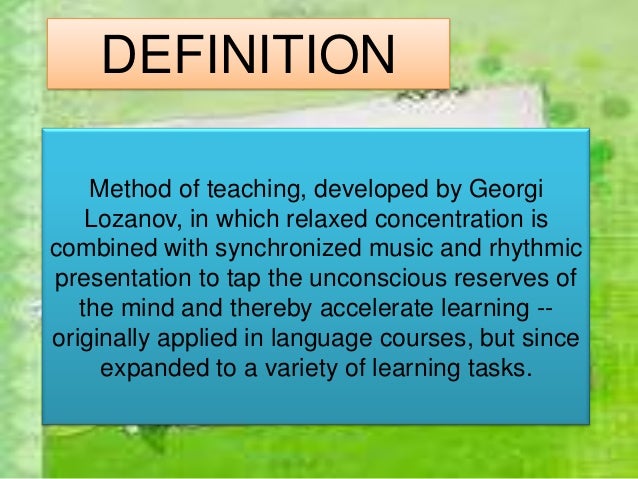

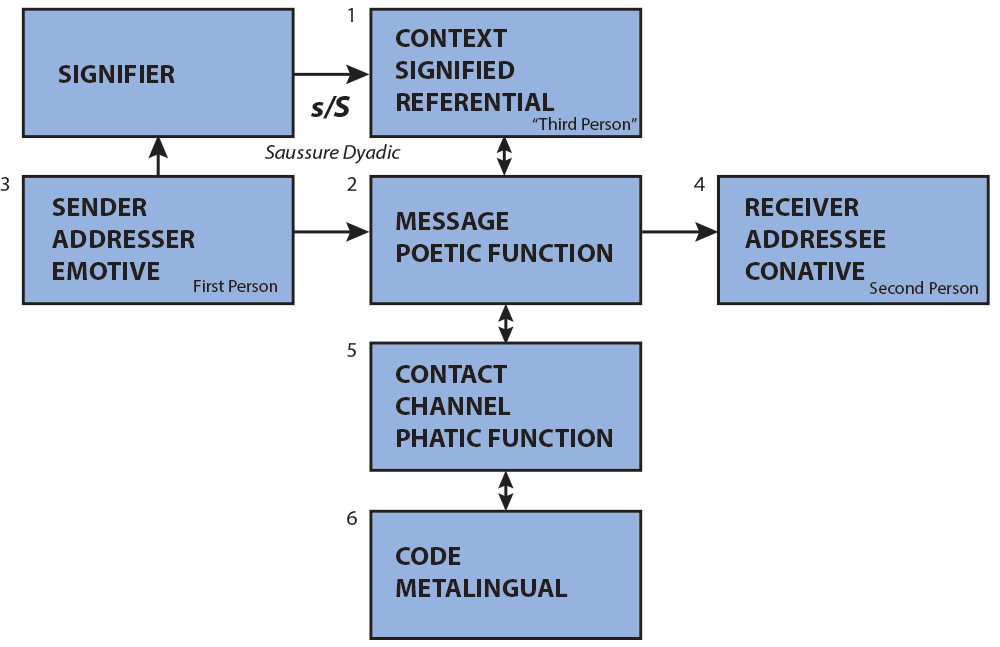
No hay comentarios.:
Publicar un comentario